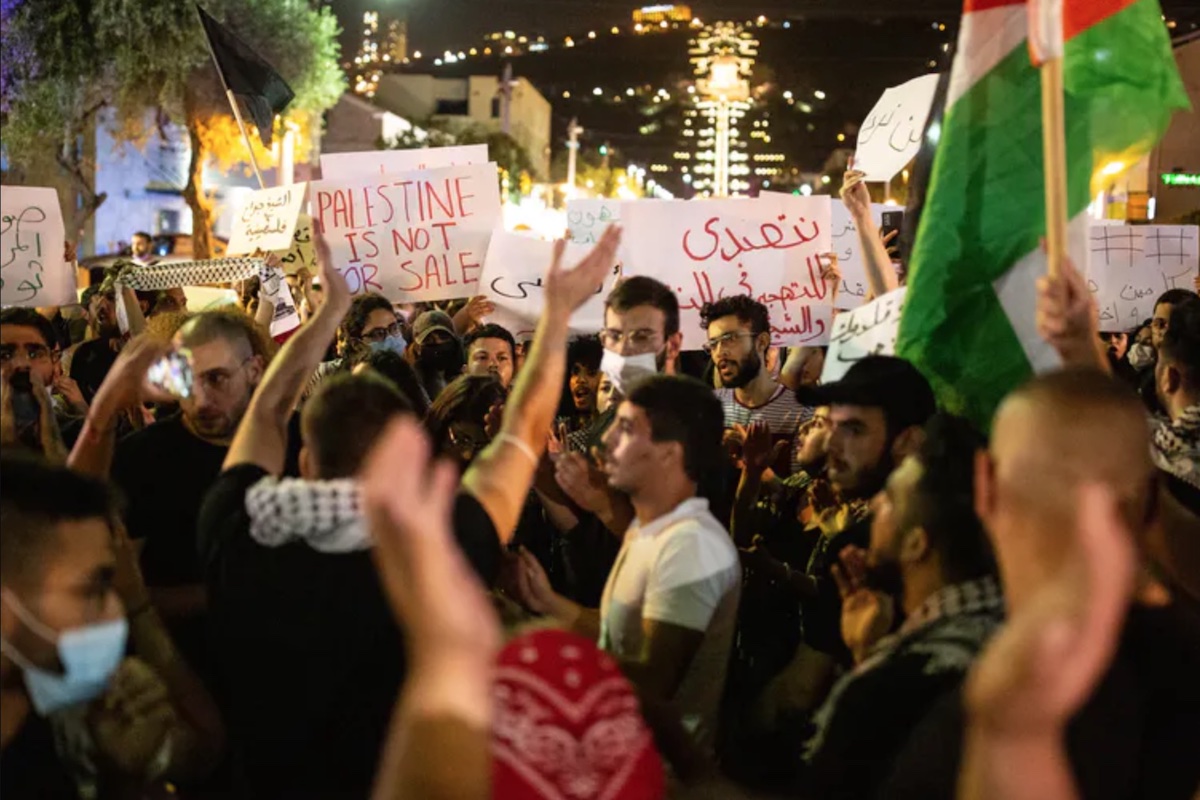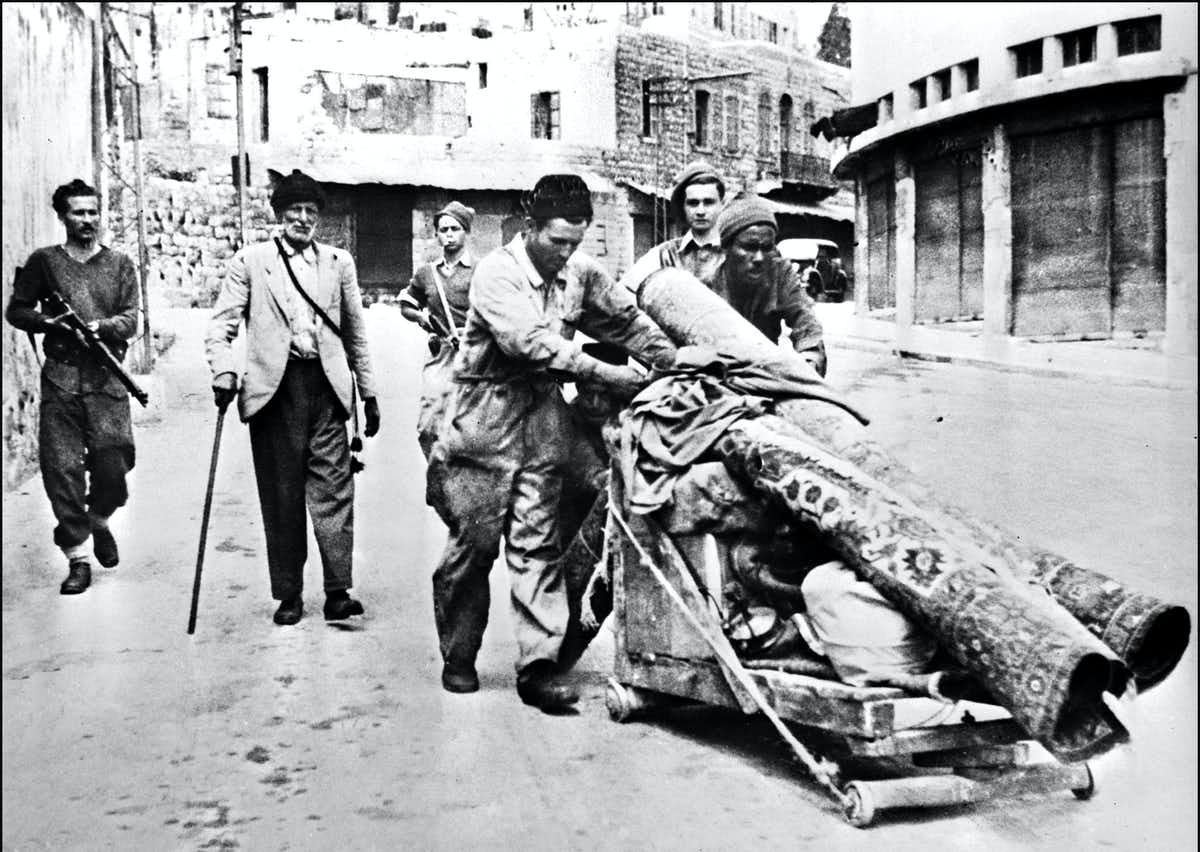

(Via Getty Images)
By Maha Nassar, University of Arizona
The world’s attention has turned again to deadly scenes of Israeli bombardment of the Gaza Strip and the launching of rockets by the militant group Hamas into Israel. It follows two weeks of protests in East Jerusalem against attempts to forcibly displace Palestinians from their homes in Sheikh Jarrah and Israeli police raids on worshippers in the al-Aqsa mosque compound.
But in towns across Israel, another important —and underreported— development is taking place. And it could change how we talk about Palestinians and Israelis.
Since May 9, 2021, thousands of Palestinian citizens of Israel, numbering some 1.9 million people and often referred to as “Arab Israelis,” have taken to the streets to express support for their fellow Palestinians in Gaza and Jerusalem. Protests are taking place in both mixed Arab-Jewish cities like Haifa, Jaffa and Lod, known as Lydda to Palestinians, as well as in predominantly Palestinian cities and towns like Nazareth and Umm al-Fahm.
The size and scope of the demonstrations have surprised many political analysts who usually discuss these Palestinians as part of the Israeli social and political fabric, separate from Palestinians elsewhere.
Meanwhile, there’s a huge development which isn’t getting much attention in the international media and that’s the dozens of riots ongoing tonight in Arab-Israeli towns. No-one saw that either and the last time we’ve seen anything on this scale was October 2000. This isn’t Hamas>
— Anshel Pfeffer אנשיל פפר (@AnshelPfeffer) May 10, 2021
But as a historian of the Palestinian citizens of Israel, I’m not surprised by this recent turn of events. Palestinian citizens of Israel have a long history of identifying with their fellow Palestinians, though rarely on this scale.
Policy of isolation, integration
As I argue in my book “Brothers Apart,” following the establishment of Israel in 1948, state officials tried to cultivate a sense of loyalty among the minority of Palestinians who remained in their homeland. It was part of a larger Israeli effort to isolate them from the vast majority of Palestinians who either fled or were expelled from the newly established state.
These “Arab Israelis” were placed under military rule until 1966 and were unable to directly contact family members living in refugee camps. Most were granted Israeli citizenship in 1952, but they faced a host of discriminatory laws that denied them access to their land, limited their economic opportunities and restricted their movements. While they could vote, form political parties and hold public office, extensive government surveillance —and punishment of those who criticized the state– created a pervasive climate of fear among these Palestinian citizens of Israel.
Discrimination and economic disadvantage continue today. Palestinian towns and villages in Israel face housing shortages and economic underdevelopment. Hiring practices that require job applicants to live in certain areas or to have served in the military —something very few Palestinian citizens do— end up pushing Palestinians into precarious low-wage jobs.
While direct housing discrimination was banned by the courts, Jewish communities often set up admissions committees that effectively limit the number of Palestinian citizens living in majority Jewish towns.
This de facto segregation is also reflected in Israel’s school system. Students in Arab state schools receive less funding per capita than those in majority Hebrew state schools.
In addition, Palestinian citizens are subjected to “stop-and-frisk” police policies. And professionals face everyday forms of racism from some Jewish Israeli colleagues who are surprised by their level of education.
Palestinian citizens of Israel have been protesting these conditions since the founding of the state, but within limits. In 1964, the Arab nationalist Ard group called for “a just solution for the Palestinian question… in accordance with the wishes of the Palestinian Arab people.” In response, the Israeli government banned the group and arrested its leaders on charges of endangering state security.
Centering Palestinian identity
Despite these restrictions, their expressions of Palestinian national identity have grown louder.
Following Israel’s occupation of the West Bank, Gaza Strip and East Jerusalem in 1967, Palestinian citizens of Israel and those under occupation met one another regularly, leading them to develop a sense of joint struggle.
That joint struggle was on display in October 2000 when thousands of Palestinian citizens rallied in Palestinian towns and mixed cities across Israel in support of Palestinians in the Occupied Territories during the second Palestinian intifada, or uprising. Israeli security forces killed 12 unarmed protesting Palestinian citizens of Israel and arrested over 600, undermining the idea that Palestinian citizens could achieve full equality in Israel.
Since then, Israel has launched several economic development and civil service initiatives aimed at integrating Palestinian citizens into the state. But these initiatives have not done much to alleviate the discrimination that Palestinian citizens still face. Moreover, the right-wing shift in Israeli politics has led to even more explicitly racist rhetoric from some quarters, including growing support for expelling Palestinian citizens from Israel altogether.
In response, more Palestinian citizens identify themselves as belonging to one people who are collectively resisting settler colonial rule. A younger generation of grassroots organizers has taken the lead, as seen in the annual commemorations of the Nakba —the loss of Palestine in 1948— every May 15.
This centering of Palestinian identity was on display in March 2021 in the Palestinian town of Umm al-Fahm. Protests against seemingly local problems —crime and gun violence— turned into an expression of Palestinian national identity as protesters waved Palestinian flags and sang Palestinian songs.
– إننا لها ، وإن اليها عائدون ??#ام الفحم pic.twitter.com/Cm6P9NL71N
— روان ? (@Rawan_19jd) March 6, 2021
The latest protests around Sheikh Jarrah and incursions in the al-Aqsa compound likewise promote a common Palestinian cause. At a rally in the mixed city of Lydd, a few miles south of Tel Aviv, one Palestinian citizen protester scaled a lamppost and replaced the Israeli flag with a Palestinian one.
Palestinians reclaiming their cities and towns during the Nakba week. In 1948, Israeli troops captured the town, expulsion of 70,000 Palestinians.
Now, in Lydd the Israeli flag taken down+replaced by Palestinian one. #FreeLydd #FreePalestine pic.twitter.com/UvH7JJ0ko0— Dr. Carol Daniel Kasbari د. كارول دانيال كسبري (@CarolDkas) May 10, 2021
Meanwhile, the funeral of Lydd protester Moussa Hassoun on May 11 drew 8,000 mourners as he was laid to rest wrapped in a Palestinian flag.
This is the funeral of Mousa Hassuna, a Palestinian man from Lyd who was martyred today. His body, wrapped in the Palestinian flag was accompanied by a crowd of 8000. Rest in power Mousa. https://t.co/DoKhqdyB8c
— Dr. Yara Hawari د. يارا هواري (@yarahawari) May 11, 2021
Since then, protests have swelled even further, leading Israeli security officials to impose a curfew on the town and call in reinforcements.
Fragmented No More?
The current protests suggest that Israeli government attempts to isolate Palestinian citizens of Israel from Palestinians in the occupied territories and in exile and to integrate them into the Israeli state have failed. And any heavy-handed reaction to demonstrators could only serve to further alienate Palestinian citizens from the state of Israel.
Scenes of police violently breaking up peaceful protests, Israeli security forces being deployed into Palestinian neighborhoods inside the country, and armed Israeli Jewish vigilantes attacking Palestinians in mixed cities could also, I believe, further reinforce the image of Israel as a colonial power in the minds of not only its marginalized Palestinian minority, but also their international supporters as well.
יפו – המפגינים צעדו 50 מטר לאורך רח יפת השוטרים התחילו לפזר ברימונים בנוסף למעצרים (מצטער על הצעקות שלי ) מתח בכל יפו #הארץ21 @Haaretz pic.twitter.com/UFgt96TPGQ
— Yanal Jbareen | ينال جبارين | ינאל ג׳בארין (@JbareenYanal) May 11, 2021
Palestinian students demonstrated in solidarity with Jerusalem and Gaza at Ben Gurion University and this is what happened: https://t.co/LkCssWZKR9
— Ben White (@benabyad) May 11, 2021
NOW: Israeli forces are invading the town of Lydd (within Israel) to repress Palestinian protest against Israeli apartheid and colonialism. pic.twitter.com/rjSMAq0Sro
— IMEU (@theIMEU) May 12, 2021
What could result is a new type of Palestinian mobilization, one that belies the idea of a fragmented people and unites all Palestinian people in a joint struggle.
This article is republished from The Conversation under a Creative Commons license. Read the original article.



